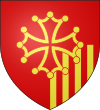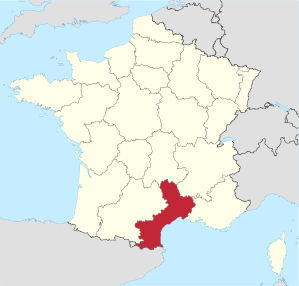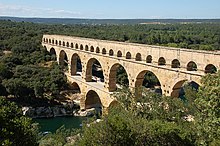Languedoc-Roussillon
|
Languedoc-Roussillon Former French region (until 2015) |
|

|

|
| Basic data | |
|---|---|
| Today part of | Occitania |
| Administrative headquarters | Montpellier |
|
population
- total January 1, 2017 |
2,810,383 inhabitants |
|
surface - total |
27,376 km² |
| Departments | 5 |
| Arrondissements | 14th |
| Cantons | 186 |
| Communities | 1,545 |
| Formerly ISO 3166-2 code | FR-K |
The Languedoc-Roussillon ( Occitan Lengadòc-Rosselhon , Catalan Llenguadoc-Rosselló ) was an administrative region in the south of France .
The region included the on the Mediterranean coast lying departments Aude , Gard , Hérault and Pyrénées-Orientales and the geographically entirely different nature and Massif Central belonging Lozere .
The region had an area of 27,376 km² and 2,810,383 inhabitants (as of January 1, 2017). The capital of the region was Montpellier .
On January 1, 2016, the region was incorporated into the new larger region of Occitania.
The names Languedoc and Roussillon are always used independently to denote the historical provinces .
geography
Languedoc-Roussillon bordered the Provence-Alpes-Côte d'Azur and Rhône-Alpes regions to the east, the Auvergne to the north and the Midi-Pyrénées region to the west . In the southwest it bordered the states of Spain and Andorra , and in the south with the Mediterranean Sea .
Languedoc-Roussillon is known for its cave world. 15 caves have been developed for tourism. You can admire the stalactite formations in amazing shapes and colors and narrow galleries or huge halls. In some caves there are also stone formations that are reminiscent of works of art, such as B. the 100,000 soldiers in the cave of Trabuc or the Méduse, a large, transparent white stalactite of the Grotte de Clamouse with a lake and an underground river.
The extraordinary inland waterway Canal du Midi from the 17th century, which connects the Garonne and thus the Atlantic with the Mediterranean, was added to the UNESCO list of World Heritage Sites in 1996 . There are impressive structures along the canal, for example the Fonserannes lock staircase near Béziers , the birthplace of the canal builder Pierre-Paul Riquet .
coat of arms
Blazon : a golden Tolosan cross in red . Four gold stakes in the fourth field .
Symbolism: The four posts are reminiscent of the Catalan Senyera .
history
Early history
The nearby Rhone Delta is one of those regions into which the Neolithic, which spread from the Levant , was probably already between 7000 and 6500 BC. Chr. Arrived. The rural culture subsequently spread both into the Rhône valley and to the west. In Languedoc-Roussillon it left a multitude of megalithic evidence in the form of dolmens ( Le Morrel de las Fadas or Lo Morrel dos Fados ) and menhirs , but also alignments (Cromlech by Lacam de Peyrarines ) . Some are also semi-megalithic ( Dolmen de Gallardet supplemented by small-format stones in drywall construction ) or covered with them ( Dolmen by Ronc Traoucat , Fringayrolles). The Dolmen de Coste-Rouge in the Hérault is very similar to the Sardinian complex of Sa Coveccada .
About 20 kilometers from Montpellier , near the small village of Viols-en-Laval , there is a famous prehistoric place: Cambous is the oldest restored village in France. It dates from between 4300 and 2200 BC. Copper Age to be applied . During these centuries the so-called Fontbouisse culture existed , to which the inhabitants of Cambous belonged. There are more than 200 small villages of this type, but barely 20% of them have been archaeologically investigated. Cambous was excavated by Henri Canet in 1967. Archaeologists from the Languedocienne Prehistory Society manage the site on a voluntary basis.
The European Prehistory Center (with a museum) is in Tautavel and a dinosaur park is in Mèze .
middle Ages
Like much of what is now southern France, Languedoc was not subjected to the French crown until the High Middle Ages (13th century). The nobility of Occitania traditionally tended to be enemies with the king of France. The pretext for this was provided by the religious and church-critical current of the Cathars , which was widespread there around this time , and was persecuted with great severity by both the king and the pope, and the flourishing Occitan culture was also destroyed. In 1209 the Albigensian Crusades began under Simon IV. De Montfort . a. killed all residents of the city of Béziers on July 22, 1209 (around 20,000); it was followed by the massacre in Minerve on July 22nd, 1210 and further atrocities in Bram , Lastours , Lavaur and elsewhere. The second crusade took place in 1226 under the direct direction of the French king, who, however, died on arrival in the war zone. A third and last crusade ended the last remnants of the Cathar culture in 1244 with the siege of the Montségur castle ; the castle Quéribus held eleven years longer stand. The fortified city of Carcassonne became the base of the (Northern) French .
Modern times
The present-day departments of Aude, Gard, Hérault and Lozère were part of the historical province of Languedoc until the beginning of the French Revolution (1789) ; what is now the Pyrénées-Orientales department formed the historic province of Roussillon .
When regions were established as operational areas of regional planning in 1956, the area still consisted of Languedoc without Roussillon (Département Pyrénées-Orientales), which was added in 1960. Since 1964 the region has been under the direction of a regional prefect. In 1972 the regions received the status of Établissements publics . The decentralization laws of 1982 gave the regions the status of collectivités territoriales ( local authorities ), which until then had only been owned by the municipalities and the départements . In 1986 the regional councils were directly elected for the first time. Since then, the region's powers vis-à-vis the central government in Paris have been gradually expanded.
On January 1, 2016, the Languedoc-Roussillon region merged with the neighboring Midi-Pyrénées region to form the Occitania region .
population
Cities
The most populous cities in Languedoc-Roussillon were:
| city | Inhabitants (year) | Department |
|---|---|---|
| Montpellier | 285,121 (2017) | Herault |
| Nîmes | 150,610 (2017) | Gard |
| Perpignan | 120,158 (2017) | Pyrénées-Orientales |
| Beziers | 77,177 (2017) | Herault |
| Narbonne | 54,700 (2017) | Aude |
| Carcassonne | 46,031 (2017) | Aude |
| Sète | 43,229 (2017) | Herault |
| Alès | 40,219 (2017) | Gard |
| Lunel | 26,239 (2017) | Herault |
| Agde | 28,609 (2017) | Herault |
language
The Languedoc part of the traditional language area of Occitan , the Roussillon to the Catalan . However, as in the rest of France, only French was the official language , which is now the mother tongue of the majority of the population. Occitan and Catalan have at least a modest status as electives in schools and colleges.
Political structure
The Languedoc-Roussillon region was divided into five departments :
| Department | prefecture | ISO 3166-2 | Arrondissements | Cantons | Communities | Inhabitants (year) | Area (km²) |
Density (inh / km²) |
||
|---|---|---|---|---|---|---|---|---|---|---|
| Aude | Carcassonne | FR-11 | 3 | 35 | 438 |
|
6.139 | 60.3 | ||
| Gard | Nîmes | FR-30 | 3 | 46 | 353 |
|
5,853 | 127.1 | ||
| Herault | Montpellier | FR-34 | 3 | 49 | 343 |
|
6.101 | 187.7 | ||
| Lozère | Mende | FR-48 | 2 | 25th | 185 |
|
5,167 | 14.8 | ||
| Pyrénées-Orientales | Perpignan | FR-66 | 3 | 31 | 226 |
|
4.116 | 115.3 |
economy
Compared with the GDP of the EU expressed in purchasing power standards reached the region in 2006 an index of 86.1 (EU-27 = 100). One of the revenue streams is viticulture.
tourism
Tourism is of great importance for the region. There are some very well-known sights in Languedoc-Roussillon:
- the Roman aqueduct bridge Pont du Gard ,
- the Canal du Midi , which can be used by houseboats ,
- the city of Nîmes (with the amphitheater still in use today ),
- Carcassonne - Europe's largest preserved fortress from the Middle Ages, one of the most magnificent cultural sights in France, since 1997 a UNESCO World Heritage Site
- Montpellier
- Sète - the Italian-influenced fishing town is idyllically located around a hill between the Mediterranean Sea and the lagoon lake Étang de Thau . A system of canals runs through the city and connects sea and lake.
- the Petite Camargue in the Rhône Delta , known among other things for its flocks of flamingos and for the white Camargue horses .
Two tourist trains run through the region:
- the "Train Jaune" (yellow train) has been running the Ligne de Cerdagne (since 1920) and is the highest railway line in France
- the 'Train du Pays Cathare et du Fenouillèdes ' (TPCF) (online at: tpcf.fr )
literature
- Ralf Nestmeyer : Languedoc-Roussillon. A travel guide. Michael Müller Verlag, Erlangen 2012, ISBN 978-3-89953-696-6 .
See also
Web links
- Languedoc-Roussillon region (French)
- Prefecture of the Languedoc-Roussillon region (French)
- Languedoc-Rousillon: a miniature France in the south of France official website (German)
- rendezvousenfrance.com - Official information site for tourism in France
Individual evidence
- ↑ Eurostat press release 23/2009: Regional GDP per inhabitant in the EU27 (PDF file; 360 kB)
Coordinates: 43 ° 38 ' N , 3 ° 38' E






